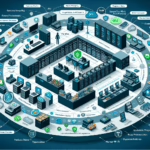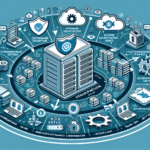Securing IT infrastructure for online payment systems is critical to protect sensitive customer data, prevent financial fraud, and ensure compliance with regulations like PCI DSS (Payment Card Industry Data Security Standard). Here’s a comprehensive approach to secure such systems:
1. PCI DSS Compliance
Adherence to PCI DSS standards is mandatory for handling payment card information. Key requirements include:
– Data Encryption: Encrypt sensitive cardholder data during transmission and storage using strong encryption protocols (e.g., TLS, AES-256).
– Access Control: Implement strong access controls, including role-based access, multi-factor authentication (MFA), and least privilege principles.
– Regular Audits: Perform regular vulnerability scans, penetration tests, and compliance assessments.
2. Network Security
Protect the payment system network from unauthorized access:
– Firewalls: Deploy and configure firewalls to restrict traffic to only necessary ports, protocols, and IP ranges.
– Network Segmentation: Segment the payment systems from other parts of the IT infrastructure to limit exposure in case of a breach.
– Intrusion Detection and Prevention Systems (IDS/IPS): Monitor and block malicious traffic in real-time.
3. Secure Servers and Virtualization
- Server Hardening: Disable unused services, close unnecessary ports, and apply security patches regularly.
- Virtualization Security: Use secure hypervisors and isolate virtual machines (VMs) handling payment systems from other workloads.
- GPU Security: If GPU resources are used for AI or analytics in payment systems, ensure proper isolation and driver updates to mitigate vulnerabilities.
4. Secure Kubernetes and Containerized Environments
If payment systems are deployed in Kubernetes or containerized environments:
– RBAC: Enforce Role-Based Access Control (RBAC) to limit who can access clusters and resources.
– Pod Security Policies: Enforce strict policies to control container behavior, such as restricting root access and privilege escalation.
– Image Scanning: Regularly scan container images for vulnerabilities before deployment.
– Secrets Management: Use Kubernetes secrets or external vaults (e.g., HashiCorp Vault) to securely store sensitive data like API keys and credentials.
5. Data Protection & Backup
- Database Security: Encrypt databases and restrict access using database firewalls and privileged account monitoring.
- Backup Encryption: Ensure backups are encrypted and stored in secure locations (on-site and off-site).
- Immutable Backups: Use immutable backup solutions to protect data from ransomware attacks.
6. Endpoint Protection
- Antivirus and EDR: Deploy endpoint detection and response (EDR) solutions to monitor and prevent malware attacks.
- Patch Management: Regularly update and patch all endpoints, including servers, workstations, and mobile devices.
- Secure Workstations: Ensure employee devices used to access payment systems are locked down with encryption, MFA, and endpoint monitoring.
7. Secure APIs and Web Applications
- Input Validation: Prevent injection attacks by validating and sanitizing user inputs.
- Web Application Firewall (WAF): Deploy a WAF to block malicious requests targeting your online payment application.
- API Security: Authenticate API calls using secure tokens (e.g., OAuth 2.0) and rate-limit API requests to prevent abuse.
8. Identity and Access Management (IAM)
- MFA: Enforce multi-factor authentication for all user accounts, especially administrators.
- SSO: Use Single Sign-On (SSO) to simplify authentication while maintaining security.
- Periodic Reviews: Regularly audit and revoke access for inactive or unauthorized users.
9. Logging and Monitoring
- Centralized Logging: Use centralized logging solutions (e.g., ELK stack, Splunk) to monitor payment system activity.
- Real-Time Alerts: Configure alerts for suspicious activity, such as multiple failed login attempts or unusual transaction patterns.
- SIEM: Deploy Security Information and Event Management (SIEM) systems to analyze and correlate logs for potential threats.
10. AI and Machine Learning for Fraud Prevention
Leverage AI and machine learning to detect fraudulent transactions:
– Behavioral Analytics: Use AI to monitor and flag anomalies in user behavior, such as unusual spending patterns.
– Real-Time Fraud Detection: Deploy machine learning models to detect and block fraudulent transactions as they occur.
11. Employee Training and Awareness
- Security Training: Train employees on identifying phishing attempts, social engineering, and best practices for handling sensitive data.
- Regular Exercises: Conduct simulated attacks (e.g., phishing campaigns) to test employee readiness.
12. Incident Response Plan
Prepare a robust incident response plan tailored for payment systems:
– Emergency Contacts: Maintain a list of contacts for rapid escalation (e.g., payment processors, card networks).
– Data Breach Protocols: Include steps for notifying customers and regulators in case of a breach.
– Testing: Regularly test the incident response plan through tabletop exercises.
13. Vendor and Third-Party Risk Management
- Vendor Security Assessments: Evaluate the security practices of third-party vendors (e.g., payment gateways).
- Contracts: Include security clauses in contracts requiring vendors to comply with PCI DSS and other standards.
- Continuous Monitoring: Monitor third-party systems connected to your infrastructure for vulnerabilities.
14. Regular Security Audits
- Penetration Testing: Conduct regular penetration tests to identify vulnerabilities in payment systems.
- Code Reviews: Perform secure code reviews on payment application software.
- Third-Party Assessments: Engage external auditors to ensure security measures are effective.
By implementing these strategies, you can significantly reduce the risk of cyberattacks and ensure the secure operation of online payment systems.



